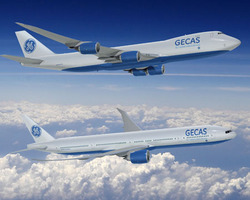- Latest edition November 27th: Solid business in Dubai
- Latest edition November 13th: Headwinds and tailwinds
- Latest edition October 30th: Quarterly reports show strength of market
- Latest edition October 16th: ABS issuance has a strong start to Q4
- Latest edition October 2nd: ABS issuance fully regains early year momentum
- Latest edition September 18th: Insurers can't appeal London judgement in Russia 'stranded assets' case
|
Aircraft Transitioning: a cutting edge service potential for aviation finance
Although aircraft leasing is centred on complex financial details it involves the ownership and operation of physical aircraft. These aircraft move between lessors and airlines on a regular basis and those exchanges require material checks and administrative tasks. This is an area that could form the basis for a strategic investment, says Sean Flannery, the EVP Technical & General Manager of GECAS, the world's largest aircraft lessor.
Each year some 2000 commercial aircraft are shifted between leasing companies and airlines across the world. Typically, a lease can extend for seven years, after which the airplane is returned to the lessor and moved on to another carrier. Every time such a move takes place extensive work is required to satisfy customer, regulator and OEM requirements. Airline customers often have unique interior design needs. Regulators require extensive paperwork and testing to ensure an aircraft is changing hands in a fit and proper state. OEMs oversee their fleets globally and also insist on tracking material that can show their aircraft are operated to world class standards. All of this must be addressed during a period of transitioning. Before passing the plane on to another carrier it must also be flight tested.
By concentrating a group of service professionals capable of addressing all of these tasks in a specific geographic centre could capture this activity. On average 50 aircraft transition each week involving leasing companies so a 20% share implies 10 aircraft being handled every seven days. If a Government can provide a site (a large airport with ample space, 24 hour flying) and include various incentives (training, tax etc) it could secure such activity which brings with it considerable employment opportunities. Currently transitioning occurs on a highly fragmented basis across numerous sites and jurisdictions. By creating a centre of excellence an individual airport could develop global leadership in this important piece of the aviation leasing business. Locating such a 'transition centre' proximate to a cluster of leasing companies would provide efficiencies for all parties. By extending the definition of aircraft leasing to include the transitioning activity a Government could further deepen it's roots in the sector.
This idea has been championed over the past year in particular by the global operational head of GECAS, the world's largest aircraft lessor, Sean Flannery (pictured). Coming from whom it does, Flannery, the Shannon, Ireland, based lessor, whose own company could conceivably be considered the No 1 customer for such a service, immediately points to the possibility involved. He has floated the idea in a number of fora over the past year, notably at 'Speednews' seminars, prompting some robust responses, he says, from OEMS on the topic. He outlined the idea to Aviation Finance as follows: It would be a centre of excellence for transitioning that would need expertise to manage the physical and legal movement of leased aircraft from one airline/lessor to another. It includes administrative, regulatory, technical and flight testing skills that are globally recognised by OEMs, regulators, airlines and lessors. He has estimated the potential market as follows: 55 p.c. of the 3,900 aircraft transitions are accounted for by leasing companies - 2,145 per annum, or 41 a week. (2009 data). So, now, the market is running at about 50 transitions a week. The new business model idea could adopt the following features: - The current, traditional basis for the relationship is bipartite, between the OEM, and first operator. A tripartite relationship involving the (present) owner/lessor would be better. - Increased stakeholder involvement would provide increased 'skin in the game' to the benefit of the industry, customers, regulators, safety and operational standards. - The issue of ringfencing and protecting intellectual property exists: an opportunity exists for an independent provider here. - Delivery of global regulatory standards This article was first published in Aviation Finance,September 15th 2011 |


